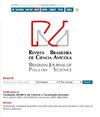樱桃副产物粉颗粒化粉对提高鸭产量和肉质性状的影响
IF 1.1
4区 农林科学
Q3 AGRICULTURE, DAIRY & ANIMAL SCIENCE
引用次数: 0
摘要
本文章由计算机程序翻译,如有差异,请以英文原文为准。
Evaluation of Pelleting Mealworm (Tenebrio Molitor) Powder with Chokeberry By-product Meal To improve Duck Production and Meat Quality Traits
This study aimed to evaluate the effects of dietary supplementation pelleted Tenebrio molitor (TM) powder with chokeberry by-product (CBP) meal on duck production and meat quality traits. A total of 180 0-day-old Pekin ducks were allocated randomly between three dietary groups viz., control, Treatment 1, and Treatment 2, with three pens per group and twenty birds per pen, characterized by increasing levels of pelleted TM powder with CBP meal in concentration of 0%, 1.5%, and 3%, respectively, and reared until 42 days of age in a completely randomized design. On day 42, the ducks were sacrificed, and breast and thigh muscles were used for meat quality evaluations. Feeding pelleted TM powder with CBP meal resulted in a significant difference in final body weight, weight gain and feed conversion ratio ( p <0.05). Additionally, a significant difference was observed in the pH of the breast meat samples ( p <0.05). As the only significant difference between the breast and thigh meat, 1,1-diphenyl-2-picryhydrazyl radical scavenging was influenced significantly by the dietary inclusion of pelleted TM powder with CBP meal ( p <0.05). However, the values of thiobarbituric acid reactive substances and meat color in both breast and thigh meat were insignificant ( p >0.05) different among all groups. To conclude, the inclusion of up to 3 % of pelleted TM powder with CBP meal in the diets of ducks did improve the growth production and antioxidant characteristics effects, which could decrease TBARS and reflected by changes in 1,1-diphenyl-2-picrylhydrazyl free DPPH radical scavenging values.
求助全文
通过发布文献求助,成功后即可免费获取论文全文。
去求助
来源期刊

Brazilian Journal of Poultry Science
农林科学-奶制品与动物科学
CiteScore
1.80
自引率
9.10%
发文量
60
审稿时长
>12 weeks
期刊介绍:
A Revista Brasileira de Ciência Avícola surgiu em 1999 a partir da necessidade que a comunidade científica possuía de um periódico para veiculação e publicação de seus trabalhos, com a publicação de três números anuais.
A Revista conta hoje com um corpo editorial altamente qualificado e com artigos científicos desenvolvidos pelos maiores especialistas da área, o que a cada dia atrai mais leitores em busca de inovação e respaldo técnico.
Devido à credibilidade que conquistou pelos esforços de sus autores, relatores e revisores, a Revista ganhou caráter de coleção, sendo consultada como fonte segura de estudo desenvolvidos na Avicultura.
A partir de 2003 – volume 5 -, a Revista passou a chamar-se Brazilian Journal of Poultry Science, e todos os trabalhos passaram a ser publicados em inglês. No mesmo ano subiu para quatro o número de revistas por volume, ampliando-se assim os trabalhos publicados anualmente.
 求助内容:
求助内容: 应助结果提醒方式:
应助结果提醒方式:


